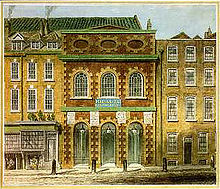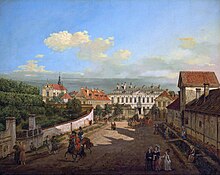Louis d'Auvigny
Louis-Aimé d'Auvigny[a] (about 1738, in Paris – after 1795, in Tulchyn,[1] Poland, now Ukraine) was an 18th-century French dancer, ballet master, choreographer and dance teacher.
Family[edit]





D'auvigny was probably the son of a writer and historian Aymé-Jean Chabaille d'Auvigny de Morinval, step brother of dancer and dance teacher Nicolas-François-Hyacinthe Dubus, known by his stage name Hyacinthe, and of the comic actors Gabriel-Éléonor-Hervé Dubus, whose stage name was Soli (Sauly), and Pierre-Louis Dubus whose stage name was Préville.[2] His mother was their sister Louise-Élisabeth Dubus (marriage 1737).[3]
In Stuttgart he married dancer Marie Claudine Toscani (1746-1768) on 6 March 1764, the daughter of Italian comedians: Giovanni Battista Toscani and Isabella Gafforia.[4]
Artistic career[edit]
After he made his debut in the ballet of the Comédie-Italienne in 1753[5] and of the Comédie-Française in 1755[6] (two years after Préville), D'Auvigny spent some years in Lyon where he danced with Jean-Georges Noverre. In 1760, the latter called him to the court of Stuttgart and gradually entrusted him with the responsibility of ballet.
When Noverre left in 1767, D'Auvigny was appointed ballet master and kept this position until Easter 1771. In 1770, he set among others the ballets of Calliroe, tragédie en musique by Antonio Sacchini presented at the theatre of Ludwigsburg Palace.[7][8] In July 1772 he danced in Paris.[9] In the winter and spring 1772/1773 he was a ballet master at the King's Theater on Haymarket in London.[10][11]
Choreographic works[edit]
In Palace Theater, Ludwigsburg
- 1768: Three ballets, music by Florian Johann Deller (in Niccolo Jommelli's Fetonte)
- 1768: Il matrimonio improviso, music by Florian Johann Deller (in Niccolo Jommelli's La schiava liberata)
- 1768: Le astuzie della fata Urgela, music by Florian Johann Deller (in Niccolo Jommelli's La schiava liberata)
- 1770: Ballo allegorico, music by Florian Johann Deller (in Antonio Sacchini's Calliroe)
- 1770: La constance, music by Florian Johann Deller (in Antonio Beroni's L’amore in musica)
- 1770: Ballo polacco, music by Florian Johann Deller (in Antonio Beroni's L’amore in musica)
In King's Theatre in the Haymarket, London
- 1773: Grand Serious Ballet in Antonio Sacchini's Il Cid
- 1773: Grand Chaconne in Antonio Sacchini's Il Cid
- 1773: Pastoral Dance in Antonio Sacchini's Il Cid
- 1773: L’Isle désert in Antonio Sacchini's Il Cid
- 1773: Apollo and Venus in Gaetano Pugnani's Apollo et Issea
- 1773: La Fête du Village in Gaetano Pugnani's Apollo et Issea
- 1773: Les Sauvages in Gaetano Pugnani's Apollo et Issea
- 1773: Les Tartares in Antonio Sacchini's Tamerlano
- 1773: Grand Ballet in Christoph Willibald Gluck's Orfeo ed Euridice
Dancing-master in Poland[edit]
In December 1773 he danced at the Royal Opera of Versailles,[12][13] There he met the Polish prince Adam Kazimierz Czartoryski and his wife Izabela, who offered him a job in Poland. He became a dance teacher at Warsaw in Nobles' Academy of the Corps of Cadets (1774-1794)[14] and a private teacher of the children of the Czartoryski princes[15] in their residences in Warsaw (in the Blue Palace), in Powązki near Warsaw (Izabela Czartoryska's summer residence, modeled on Marie Antoinette's Hameau de la Reine) and sometimes at the Czartoryski Palace in Puławy. From 1795 he worked as a dance teacher in the residence of count Stanisław Szczęsny Potocki in Tulchyn.[1]
D'Auvigny's death belongs to Julian Ursyn Niemcewicz's pen: "already advanced in years, a resident of Tulchyn, he took a young wife, and died on his wedding night – a harsh lesson", Niemcewicz comments, "for old men".[1][16]
He was the father of painter-miniaturist Charles (Carl, Karol) d'Auvigny (1 September 1765, Ludwigsburg[17] - 4 February 1830, Warsaw[18]).
Notes[edit]
- ^ His name was also recorded as: Dauvigny and D’Auvigne, D’Auvigni, D’auvigny, d’Avigny, Dauvigni, Davigni, Davigny, Douigny, Douvigny, Dovigny, Dovini, Dovinié, Dowini, Dowinni; and in Poland he was given Polish first name Ludwik.
References[edit]
- ^ a b c Julian Ursyn Niemcewicz, Pamiętniki czasów moich, Warszawa, Państwowy Instytut Wydawniczy, 1957, v. I, p. 55.
- ^ Jean-Jacques Olivier, Pierre-Louis Dubus-Préville de la Comédie-Française 1721-1799, Paris: Societe Francaise d'Impr. et de Librairie, Paris, 1913.
- ^ Auguste Jal, Dictionnaire critique de biographie et d'histoire: errata et supplément pour tous les Dictionnaires historiques d’après des documents authentiques inédits, Henri Plon, Imprimeur-Édireur, Paris, 1867, p. 1000.
- ^ Eberhard Schauer, Das Persolan des Württembergischen Hoftheaters 1750-1800. Ein Lexikon der Hofmusiker, Tänzer, Operisten und Hilfskräfte. In: Musik und Musiker am Stuttgarter Hoftheater (1750-1918). Quellen und Studien, Herausgegeben Reiner Nägle, Wurttembergische Landesbibliothek, Stuttgart, 2000, p. 57. ISBN 3-88282-054-3
- ^ Les Spectacles de Paris, ou Suite du Calendrier historique et chronologique des théatres, Veuve Duchesne, 1754
- ^ Les spectacles de Paris, ou calendrier historique & chronologique des théâtres, Duchesne, 1756
- ^ Mattia Verazi, Calliroe : tragédie en musique; presented on the Grand Theatre of Louisbourg on the day of the birth of His Highness Serenissime Monsignor the Duke Regnant of Wirtenberg and Teck etc. The music was composed expressly by Mr. Antoine Sacchini, Kapelmeister, Napolitan. Ballets drawn from the very subject, are invented by the author of Tragedy, & performed by Monsieur Dauvigny, maître de ballets of S. A. S. The Decorations are the invention of Mr. Josué Scotti, painter of the Theatre of the Court of Justice of the United Kingdom. [Stuttgart], Cotta, 1770, p. 167.
- ^ Verazi, Mattia; Sacchini (July 18, 1770). "Callirhoe: Ein Singspiel, welches an dem hohen Geburts-Fest, Seiner Regierenden Herzoglichen Durchlaucht, zu Würtemberg auf der grossen Herzoglichen Schaubühne in Ludwigsburg vorgestellet worden".
{{cite web}}: CS1 maint: multiple names: authors list (link) - ^ Sylvie Bouissou, Denis Herlin, Pascal Denécheau, Jean-Philippe Rameau, catalogue thématique des œuvres musicales, t. 2, CNRS-BNF, Paris, 2003, p. 151.
- ^ Emmett Langdon Avery, The London Stage, 1660-1800: 1747-1776, edited with a critical introd. by G. W. Stone, Southern Illinois University Press, 1968, p. 1691.
- ^ "Image 3 of Il Cid : an opera; as performed at the King's Theatre in the Hay-Market". Library of Congress.
- ^ Sabinus, lyric tragedy in five acts, presented before Her Majesty in Versailles on 4 December 1773.
- ^ Emelinde, tragedie-lyrique, in five actes. Performed in front of his majesty in Versailles, on 11 December 1773.
- ^ Kamila Mrozowska, Szkoła rycerska Stanisława Augusta Poniatowskiego (1765-1794), Zakład Naukowy im. Ossolińskich, Wrocław, 1961, p. 163 and 234.
- ^ Julian Ursyn Niemcewicz, Pamiętniki czasów moich, Warszawa, Państwowy Instytut Wydawniczy, 1957, t. I, p. 90.
- ^ Nina Taylor, F. D. Kniaźnin and The Polish Balloon, in: Politics and Literature in Eastern Europe, edited by Celia Hawkesworth, St. Martin's Press INC, New York, 1992, p. 136-137. ISBN 978-0-312-07991-8
- ^ Landeskirchliches Archiv Stuttgart, Dekanat Ludwigsburg, Ludwigsburg, Taufregister 1764-1773, p. 128, Band 3, Bild 78.
- ^ "Kurier Warszawski", number 35 from 1830, from 6 February 1830, p. 169.
See also[edit]
